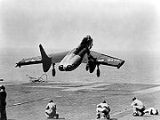
F7U Cutlass
Encyclopedia
The Vought F7U Cutlass was a United States Navy
carrier
-based jet fighter
and fighter-bomber
of the early Cold War
era. It was a highly unusual, semi-tailless design, allegedly based on aerodynamic data and plans captured from the German Arado
company at the end of World War II
, though Vought designers denied any link to the German research at the time. The F7U was the last aircraft designed by Rex Beisel
, who was responsible for the first fighter ever designed specifically for the US Navy, the Curtiss TS-1 of 1922.
Regarded as a radical departure from traditional aircraft design, the Cutlass suffered from numerous technical and handling problems throughout its short service career. The type was responsible for the deaths of four test pilots and 21 other U.S. Navy pilots. Over one quarter of all Cutlasses built were destroyed in accidents. The poor safety record was largely the result of the advanced design built to apply new aerodynamic theories and insufficiently powerful, unreliable engines.
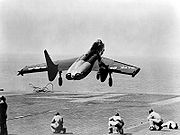 The Cutlass was Vought's entry to a U.S. Navy competition for a new carrier capable day fighter opened on 1 June 1945. The requirements were for an aircraft that was able to fly at 600 mph (966 km/h) at 40,000 ft (12,192 m). The design featured broad chord
The Cutlass was Vought's entry to a U.S. Navy competition for a new carrier capable day fighter opened on 1 June 1945. The requirements were for an aircraft that was able to fly at 600 mph (966 km/h) at 40,000 ft (12,192 m). The design featured broad chord
, low aspect ratio
, swept wings, with twin wing-mounted tail fins either side of a short fuselage
. The cockpit
was situated well forward to provide good visibility for the pilot
during aircraft carrier approaches
. The design was given the company type number of V-346 and then the designation F7U when it was announced the winner of the competition.
Pitch and roll control was provided by elevon
s, though Vought called these surfaces "ailevators" at the time. Slats
were fitted to the entire span
of the leading edge
. All controls were hydraulically-powered. The very long nose landing gear
strut required for high angle of attack
takeoff
s was rather weak, and a collapse could seriously jeopardize the pilot's safety. The F7U was also largely let down by its underpowered Westinghouse
turbojets, an engine which some pilots wryly observed put out less heat than the same company's toaster
s. Naval aviators referred to the F7U as the "gutless cutlass" or, in kinder moments, as the "praying mantis".
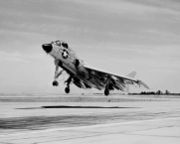
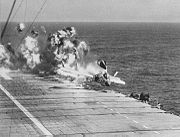 Three prototypes were ordered in 1946, with the first example flying on 29 September 1948, piloted by Vought's Chief Test Pilot, J. Robert Baker. The maiden flight took place from Naval Air Station Patuxent River
Three prototypes were ordered in 1946, with the first example flying on 29 September 1948, piloted by Vought's Chief Test Pilot, J. Robert Baker. The maiden flight took place from Naval Air Station Patuxent River
and was not without its problems. During testing one of the protypes reached a maximum speed of 625 mph (1,058 km/h)
Production orders were placed for the F7U-1 in a specification very close to the prototypes, and further developed F7U-2 and F7U-3 versions with more powerful engines. Because of development problems with the powerplant, however, the F7U-2 would never be built, while the F7U-3 would incorporate many refinements suggested by tests of the -1. The first 16 F7U-3s had non-afterburning Allison J35
-29 engines. The -3 with its Westinghouse J46
-WE-8B turbojets would eventually become the definitive production version, with 288 aircraft equipping 13 U.S. Navy squadrons. Further development stopped once the Vought F8U Crusader flew.
The F7U bore the fleet nickname of the Gutless Cutlass in reference to its lack of sufficient engine thrust
; consequently its carrier landing and takeoff performance was notoriously poor. The J35 was actually known to flameout in the rain, a very serious fault.
The first fleet squadron to receive F7Us was Fighter Squadron 81 (VF-81) in April 1954; the last with Cutlasses was Attack Squadron 66 (VA-66) in November 1957. Few squadrons made deployments with the type, and most "beached" them ashore during part of the cruise owing to operating difficulties. Those units known to have taken the type to sea were:
Fighter Squadron 124 (VF-124), USS Hancock (CVA-19), August 1955 - March 1956;
Fighter Squadron 81 (VF-81), USS Ticonderoga (CVA-14), November 1955 - August 1956;
Attack Squadron 86 (VA-86), USS Forrestal (CVA-59), January - March 1956 Shakedown Cruise;
Attack Squadron 83 (VA-83), USS Intrepid (CVA-11), March - September 1956;
VA-116, USS Hancock (CVA-19),
Attack Squadron 151 (VA-151), USS Lexington (CVA-16),
Attack Squadron 212 (VA-212), USS Bon Homme Richard (CVA-31), August 1956 - February 1957.
Air Test and Evaluation Squadron 4 (VX-4), USS Shangri-La (CVA-38) and USS Lexington (CVA-16),
, flew two F7U-1 Cutlasses as a side demonstration during their 1953 show season in an effort to promote the new aircraft, but did not use them as part of their regular formation demonstration. Both the pilots and ground crews found the aircraft generally unsatisfactory and it was apparent that the type was still experiencing teething troubles.
During the Blue Angels' first airshow appearance in 1953, pilot LT Edward "Whitey" Feightner
, the former program manager for the F7U, experienced a total loss of hydraulics on a full afterburner takeoff and steep climb. While trying to gain enough altitude for ejection he was able to stay with the aircraft until the back up system came on. He clipped trees on the end of the runway, causing the left engine to flame out. With hydraulic fluid streaming back in a bright flame, he made a hard turn and got the plane back on the runway, much to the excitement of the crowd. Later, while traveling to an airshow at Naval Air Station Glenview in Chicago, Illinois, Blue Angel pilot LT Harding MacKnight experienced an engine flameout in his Cutlass, forcing him to make an emergency landing at NAS Glenview. Traveling with him, LT "Whitey" Feightner was redirected to make his landing at Chicago's former Orchard Airpark, which had been expanded and renamed O'Hare Airport. The runway had just been completed and was covered with peach baskets to prevent aircraft from landing until it was opened. LT Feightner was told to ignore the baskets and land on the new runway. As a result, LT Feightner's F7U became the first aircraft to land on the new runway for Chicago's O'Hare International Airport.
Following these incidents, the two F7U were deemed unsuitable for demonstration flying and were flown to Naval Air Station Memphis, Tennessee, where they were abandoned to become aircraft maintenance instructional airframes for the Naval Technical Training Center.
F7U-1
F7U-2
XF7U-3
F7U-3
 F7U-3P
F7U-3P
F7U-3M
A2U-1
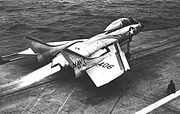
F7U-3 BuNo 128451
F7U-3 BuNo 129554
F7U-3 BuNo 129565
F7U-3 BuNo 129622
 F7U-3 BuNo 129642
F7U-3 BuNo 129642
F7U-3 BuNo 129655
F7U-3 BuNo 129685
United States Navy
The United States Navy is the naval warfare service branch of the United States Armed Forces and one of the seven uniformed services of the United States. The U.S. Navy is the largest in the world; its battle fleet tonnage is greater than that of the next 13 largest navies combined. The U.S...
carrier
Aircraft carrier
An aircraft carrier is a warship designed with a primary mission of deploying and recovering aircraft, acting as a seagoing airbase. Aircraft carriers thus allow a naval force to project air power worldwide without having to depend on local bases for staging aircraft operations...
-based jet fighter
Fighter aircraft
A fighter aircraft is a military aircraft designed primarily for air-to-air combat with other aircraft, as opposed to a bomber, which is designed primarily to attack ground targets...
and fighter-bomber
Fighter-bomber
A fighter-bomber is a fixed-wing aircraft with an intended primary role of light tactical bombing and also incorporating certain performance characteristics of a fighter aircraft. This term, although still used, has less significance since the introduction of rockets and guided missiles into aerial...
of the early Cold War
Cold War
The Cold War was the continuing state from roughly 1946 to 1991 of political conflict, military tension, proxy wars, and economic competition between the Communist World—primarily the Soviet Union and its satellite states and allies—and the powers of the Western world, primarily the United States...
era. It was a highly unusual, semi-tailless design, allegedly based on aerodynamic data and plans captured from the German Arado
Arado Flugzeugwerke
Arado Flugzeugwerke was a German aircraft manufacturer, originally established as the Warnemünde factory of the Flugzeugbau Friedrichshafen firm, that produced military hydroplanes during the First World War.-History:...
company at the end of World War II
World War II
World War II, or the Second World War , was a global conflict lasting from 1939 to 1945, involving most of the world's nations—including all of the great powers—eventually forming two opposing military alliances: the Allies and the Axis...
, though Vought designers denied any link to the German research at the time. The F7U was the last aircraft designed by Rex Beisel
Rex Beisel
Rex Buren Beisel was an aeronautical engineer who led the design of the Vought F7U Cutlass, Vought F4U Corsair and won the Wright Brothers Medal in 1934 for work related to the cooling of radial aircraft engines. Beisel grew up in Cumberland, Washington and graduated from the University of...
, who was responsible for the first fighter ever designed specifically for the US Navy, the Curtiss TS-1 of 1922.
Regarded as a radical departure from traditional aircraft design, the Cutlass suffered from numerous technical and handling problems throughout its short service career. The type was responsible for the deaths of four test pilots and 21 other U.S. Navy pilots. Over one quarter of all Cutlasses built were destroyed in accidents. The poor safety record was largely the result of the advanced design built to apply new aerodynamic theories and insufficiently powerful, unreliable engines.
Design and development

Chord (aircraft)
In aeronautics, chord refers to the imaginary straight line joining the trailing edge and the center of curvature of the leading edge of the cross-section of an airfoil...
, low aspect ratio
Aspect ratio
The aspect ratio of a shape is the ratio of its longer dimension to its shorter dimension. It may be applied to two characteristic dimensions of a three-dimensional shape, such as the ratio of the longest and shortest axis, or for symmetrical objects that are described by just two measurements,...
, swept wings, with twin wing-mounted tail fins either side of a short fuselage
Fuselage
The fuselage is an aircraft's main body section that holds crew and passengers or cargo. In single-engine aircraft it will usually contain an engine, although in some amphibious aircraft the single engine is mounted on a pylon attached to the fuselage which in turn is used as a floating hull...
. The cockpit
Cockpit
A cockpit or flight deck is the area, usually near the front of an aircraft, from which a pilot controls the aircraft. Most modern cockpits are enclosed, except on some small aircraft, and cockpits on large airliners are also physically separated from the cabin...
was situated well forward to provide good visibility for the pilot
Aviator
An aviator is a person who flies an aircraft. The first recorded use of the term was in 1887, as a variation of 'aviation', from the Latin avis , coined in 1863 by G. de la Landelle in Aviation Ou Navigation Aérienne...
during aircraft carrier approaches
Final approach (aviation)
A final approach is the last leg in an aircraft's approach to landing. In aviation radio terminology, it is often shortened to "final".In a standard airport landing pattern, which is usually used under visual meteorological conditions , aircraft turn from base leg to final within one to two miles...
. The design was given the company type number of V-346 and then the designation F7U when it was announced the winner of the competition.
Pitch and roll control was provided by elevon
Elevon
Elevons are aircraft control surfaces that combine the functions of the elevator and the aileron , hence the name. They are frequently used on tailless aircraft such as flying wings. An elevon that is not part of the main wing, but instead is a separate tail surface, is a stabilator...
s, though Vought called these surfaces "ailevators" at the time. Slats
Leading edge slats
Slats are aerodynamic surfaces on the leading edge of the wings of fixed-wing aircraft which, when deployed, allow the wing to operate at a higher angle of attack. A higher coefficient of lift is produced as a result of angle of attack and speed, so by deploying slats an aircraft can fly at slower...
were fitted to the entire span
Wingspan
The wingspan of an airplane or a bird, is the distance from one wingtip to the other wingtip. For example, the Boeing 777 has a wingspan of about ; and a Wandering Albatross caught in 1965 had a wingspan of , the official record for a living bird.The term wingspan, more technically extent, is...
of the leading edge
Leading edge
The leading edge is the part of the wing that first contacts the air; alternatively it is the foremost edge of an airfoil section. The first is an aerodynamic definition, the second a structural one....
. All controls were hydraulically-powered. The very long nose landing gear
Landing Gear
Landing Gear is Devin the Dude's fifth studio album. It was released on October 7, 2008. It was his first studio album since signing with the label Razor & Tie. It features a high-profile guest appearance from Snoop Dogg. As of October 30, 2008, the album has sold 18,906 copies.-Track...
strut required for high angle of attack
Angle of attack
Angle of attack is a term used in fluid dynamics to describe the angle between a reference line on a lifting body and the vector representing the relative motion between the lifting body and the fluid through which it is moving...
takeoff
Takeoff
Takeoff is the phase of flight in which an aerospace vehicle goes from the ground to flying in the air.For horizontal takeoff aircraft this usually involves starting with a transition from moving along the ground on a runway. For balloons, helicopters and some specialized fixed-wing aircraft , no...
s was rather weak, and a collapse could seriously jeopardize the pilot's safety. The F7U was also largely let down by its underpowered Westinghouse
Westinghouse Electric (1886)
Westinghouse Electric was an American manufacturing company. It was founded in 1886 as Westinghouse Electric Company and later renamed Westinghouse Electric Corporation by George Westinghouse. The company purchased CBS in 1995 and became CBS Corporation in 1997...
turbojets, an engine which some pilots wryly observed put out less heat than the same company's toaster
Toaster
The toaster is typically a small electric kitchen appliance designed to toast multiple types of bread products. A typical modern two-slice toaster draws anywhere between 600 and 1200 W and makes toast in 1 to 3 minutes...
s. Naval aviators referred to the F7U as the "gutless cutlass" or, in kinder moments, as the "praying mantis".
Operational history


Naval Air Station Patuxent River
"Pax River" redirects here. For the river, see Patuxent River.Naval Air Station Patuxent River , also known as NAS Pax River, is a United States Naval Air Station located in St. Mary's County, Maryland on the Chesapeake Bay near the mouth of the Patuxent River. It is home to the U.S...
and was not without its problems. During testing one of the protypes reached a maximum speed of 625 mph (1,058 km/h)
Production orders were placed for the F7U-1 in a specification very close to the prototypes, and further developed F7U-2 and F7U-3 versions with more powerful engines. Because of development problems with the powerplant, however, the F7U-2 would never be built, while the F7U-3 would incorporate many refinements suggested by tests of the -1. The first 16 F7U-3s had non-afterburning Allison J35
Allison J35
|-See also:-External links:*...
-29 engines. The -3 with its Westinghouse J46
Westinghouse J46
|-References:...
-WE-8B turbojets would eventually become the definitive production version, with 288 aircraft equipping 13 U.S. Navy squadrons. Further development stopped once the Vought F8U Crusader flew.
The F7U bore the fleet nickname of the Gutless Cutlass in reference to its lack of sufficient engine thrust
Thrust
Thrust is a reaction force described quantitatively by Newton's second and third laws. When a system expels or accelerates mass in one direction the accelerated mass will cause a force of equal magnitude but opposite direction on that system....
; consequently its carrier landing and takeoff performance was notoriously poor. The J35 was actually known to flameout in the rain, a very serious fault.
The first fleet squadron to receive F7Us was Fighter Squadron 81 (VF-81) in April 1954; the last with Cutlasses was Attack Squadron 66 (VA-66) in November 1957. Few squadrons made deployments with the type, and most "beached" them ashore during part of the cruise owing to operating difficulties. Those units known to have taken the type to sea were:
Fighter Squadron 124 (VF-124), USS Hancock (CVA-19), August 1955 - March 1956;
Fighter Squadron 81 (VF-81), USS Ticonderoga (CVA-14), November 1955 - August 1956;
Attack Squadron 86 (VA-86), USS Forrestal (CVA-59), January - March 1956 Shakedown Cruise;
Attack Squadron 83 (VA-83), USS Intrepid (CVA-11), March - September 1956;
VA-116, USS Hancock (CVA-19),
Attack Squadron 151 (VA-151), USS Lexington (CVA-16),
Attack Squadron 212 (VA-212), USS Bon Homme Richard (CVA-31), August 1956 - February 1957.
Air Test and Evaluation Squadron 4 (VX-4), USS Shangri-La (CVA-38) and USS Lexington (CVA-16),
Blue Angels
The Navy Flight Demonstration Squadron, the Blue AngelsBlue Angels
The United States Navy's Navy Flight Demonstration Squadron, popularly known as the Blue Angels, was formed in 1946 and is currently the oldest formal flying aerobatic team...
, flew two F7U-1 Cutlasses as a side demonstration during their 1953 show season in an effort to promote the new aircraft, but did not use them as part of their regular formation demonstration. Both the pilots and ground crews found the aircraft generally unsatisfactory and it was apparent that the type was still experiencing teething troubles.
During the Blue Angels' first airshow appearance in 1953, pilot LT Edward "Whitey" Feightner
Edward L. Feightner
Rear Admiral Edward L. "Whitey" Feightner is a retired United States Navy officer who fought in a number of significant battles in the World War II Pacific Theater of Operations...
, the former program manager for the F7U, experienced a total loss of hydraulics on a full afterburner takeoff and steep climb. While trying to gain enough altitude for ejection he was able to stay with the aircraft until the back up system came on. He clipped trees on the end of the runway, causing the left engine to flame out. With hydraulic fluid streaming back in a bright flame, he made a hard turn and got the plane back on the runway, much to the excitement of the crowd. Later, while traveling to an airshow at Naval Air Station Glenview in Chicago, Illinois, Blue Angel pilot LT Harding MacKnight experienced an engine flameout in his Cutlass, forcing him to make an emergency landing at NAS Glenview. Traveling with him, LT "Whitey" Feightner was redirected to make his landing at Chicago's former Orchard Airpark, which had been expanded and renamed O'Hare Airport. The runway had just been completed and was covered with peach baskets to prevent aircraft from landing until it was opened. LT Feightner was told to ignore the baskets and land on the new runway. As a result, LT Feightner's F7U became the first aircraft to land on the new runway for Chicago's O'Hare International Airport.
Following these incidents, the two F7U were deemed unsuitable for demonstration flying and were flown to Naval Air Station Memphis, Tennessee, where they were abandoned to become aircraft maintenance instructional airframes for the Naval Technical Training Center.
Variants
XF7U-1- Three prototypes ordered on 25 June 1946. First flight, 29 September 1948, all three aircraft were destroyed in crashes.
F7U-1
- The initial production version, 14 built. Powered by two J34-WE-32 engines.
F7U-2
- Proposed version, planned to be powered by two Westinghouse J34-WE-42Westinghouse J34-See also:-External links:* http://www.arkairmuseum.org/engines/engine-westinghouse.php* http://www.globalsecurity.org/military/systems/aircraft/systems/j34.htm...
engines with afterburnerAfterBurnerThe AfterBurner is a lighting solution for the Game Boy Advance system that was created by Triton-Labs.Originally, portablemonopoly.net was a website created to petition Nintendo to put some kind of light in their Game Boy Advance system...
, but the order for 88 aircraft was cancelled.
XF7U-3
- Designation given to one aircraft built as the prototype for the F7U-3, BuNo 128451. First flight: 20 December 1951.
F7U-3
- The definitive production version, 192 built.

- Photo-reconnaissance version, 12 built. With a 25 in longer nose and equipped with photo flash cartridges none of these aircraft saw operational service, being used only for research and evaluation purposes.
F7U-3M
- This missile capable version was armed with four AAM-N-2 Sparrow I air-to-air beam-riding missiles, 98 built. A total of 48 F7U-3 existing airframes were upgraded to F7U-3M standard. An order for 202 aircraft was cancelled.
A2U-1
- Designation given to a cancelled order of 250 aircraft to be used in the ground attack role.
Operators

-
- VC-3
- VX-3
- VX-4VX-4VX-4, Air Test and Evaluation Squadron Four, , commonly referred to by its nickname, The Evaluators) was a United States Navy air test and evaluation squadron based at Naval Air Station Point Mugu, California...
- VX-5
- VA-12VA-12VA-12, Attack Squadron 12 was an attack squadron of the United States Navy that was active during the Cold War. Nicknamed the "Flying Ubangis," they were based out of Naval Air Station Cecil Field, Florida. The squadron flew two combat tours during the Vietnam War...
- VA-34VA-34VA-34 has the following meanings:*Attack Squadron 34 *State Route 34...
- VF-81 / VA-66
- VF-83 / VA-83
- VA-86VA-86VA-86 has the following meanings:*Attack Squadron 86 *State Route 86...
- VA-116
- VF-122
- VF-124VF-124Fighter Squadron 124 was a fleet replacement squadron of the United States Navy. Known as the Gunfighters, they were active from 1958 through 1994...
- VA-126
- VF-151 / VA-151
- VF-212 / VA-212
Survivors
Seven F7U Cutlass aircraft are known to have survived.F7U-3 BuNo 128451
- Prototype F7U-3. Formerly at the Fred E. Weisbroad Aviation Museum/International B-24 Museum in Pueblo, ColoradoPueblo, ColoradoPueblo is a Home Rule Municipality that is the county seat and the most populous city of Pueblo County, Colorado, United States. The population was 106,595 in 2010 census, making it the 246th most populous city in the United States....
. It was unrestored and incomplete, in poor condition. It is now at the USS Midway (CV-41)USS Midway (CV-41)USS Midway was an aircraft carrier of the United States Navy, the lead ship of her class, and the first to be commissioned after the end of World War II...
Museum in San Diego, CaliforniaSan Diego, CaliforniaSan Diego is the eighth-largest city in the United States and second-largest city in California. The city is located on the coast of the Pacific Ocean in Southern California, immediately adjacent to the Mexican border. The birthplace of California, San Diego is known for its mild year-round...
, to be combined with BuNo 129565 to make one complete aircraft.
F7U-3 BuNo 129554
- Purchased by Len Berryman from Geiger Field, Washington in May 1958 and displayed outside the Berryman War Memorial Park in Bridgeport, Washington from 1958 until 1992. In June 1992 it was sold to Tom Cathcart of Ephrata, Washington for restoration to eventual flying condition. This aircraft is currently undergoing restoration at the Museum of FlightMuseum of FlightThe Museum of Flight is a private non-profit air and space museum at King County International Airport , south of downtown Seattle, Washington. It was established in 1965 and is fully accredited by the American Association of Museums...
in Everett, WashingtonEverett, WashingtonEverett is the county seat of and the largest city in Snohomish County, Washington, United States. Named for Everett Colby, son of founder Charles L. Colby, it lies north of Seattle. The city had a total population of 103,019 at the 2010 census, making it the 6th largest in the state and...
.
F7U-3 BuNo 129565
- Was undergoing restoration for display at the USS Hornet (CV-12)USS Hornet (CV-12)USS Hornet is a United States Navy aircraft carrier of the Essex class. Construction started in August 1942; she was originally named , but was renamed in honor of the , which was lost in October 1942, becoming the eighth ship to bear the name.Hornet was commissioned in November 1943, and after...
Museum at the former NAS Alameda in Alameda, CaliforniaAlameda, CaliforniaAlameda is a city in Alameda County, California, United States. It is located on Alameda Island and Bay Farm Island, and is adjacent to Oakland in the San Francisco Bay. The Bay Farm Island portion of the city is adjacent to the Oakland International Airport. At the 2010 census, the city had a...
. Has now been transferred to USS Midway (CV-41)USS Midway (CV-41)USS Midway was an aircraft carrier of the United States Navy, the lead ship of her class, and the first to be commissioned after the end of World War II...
Museum in San Diego, CaliforniaSan Diego, CaliforniaSan Diego is the eighth-largest city in the United States and second-largest city in California. The city is located on the coast of the Pacific Ocean in Southern California, immediately adjacent to the Mexican border. The birthplace of California, San Diego is known for its mild year-round...
for final restoration and display.
F7U-3 BuNo 129622
- Ex VA-34 / VA-12 aircraft that was flown to Naval Air Reserve Training Unit (NARTU) Glenview, NAS Glenview, Illinois, where it was sporadically flown by Naval Air Reserve pilots and used for instruction of enlisted Naval Reserve aircraft maintenance personnel; ownership was then transferred to the Northbrook East Civic Association and the aircraft was moved to the Oaklane Elementary School for playground use. It was subsequently removed and dissected to be sold for its engines. Forward fuselage was part of Earl Reinart's collection in Mundelein, Illinois, while the rest of the aircraft went to J-46 dragster builder Fred Sibley in Elkhart, Inidana. Its components are currently reunited in the collection of noted F7U historian Al Casby of Phoenix, Arizona.

- On display at the Wings of Freedom Aviation MuseumWings of Freedom Aviation MuseumThe Wings of Freedom Aviation Museum is a non-profit museum in Horsham, Pennsylvania. It is adjacent to Naval Air Station Joint Reserve Base Willow Grove...
at the Naval Air Station Joint Reserve Base Willow Grove, Pennsylvania. The aircraft belonged to Attack Squadron 12 (VA-12) and was flown to NAS Willow Grove in May 1957 to take part in an air show. Upon arrival the aircraft was stricken from active duty. It was transferred to the Naval Reserve for use as a ground training aircraft, and eventually placed as a gate guard in front of the base on US Route 611. The airframe has only 326.3 hours total flight time.
F7U-3 BuNo 129655
- Although marked as an F7U-3M, this aircraft on display at the National Museum of Naval AviationNational Museum of Naval AviationThe National Museum of Naval Aviation is a military and aerospace museum located at Naval Air Station Pensacola, Florida. The museum opened in 1962....
at NAS Pensacola, Florida is in reality an F7U-3 which was factory upgraded to F7U-3M standards. Formerly displayed at Griffith Park, California.
F7U-3 BuNo 129685
- Located for many years at the aircraft collection of Walter Soplata in Newbury, Ohio. Like most aircraft on this famous farm, the aircraft appears complete, though it is exposed to the elements and unrestored.

